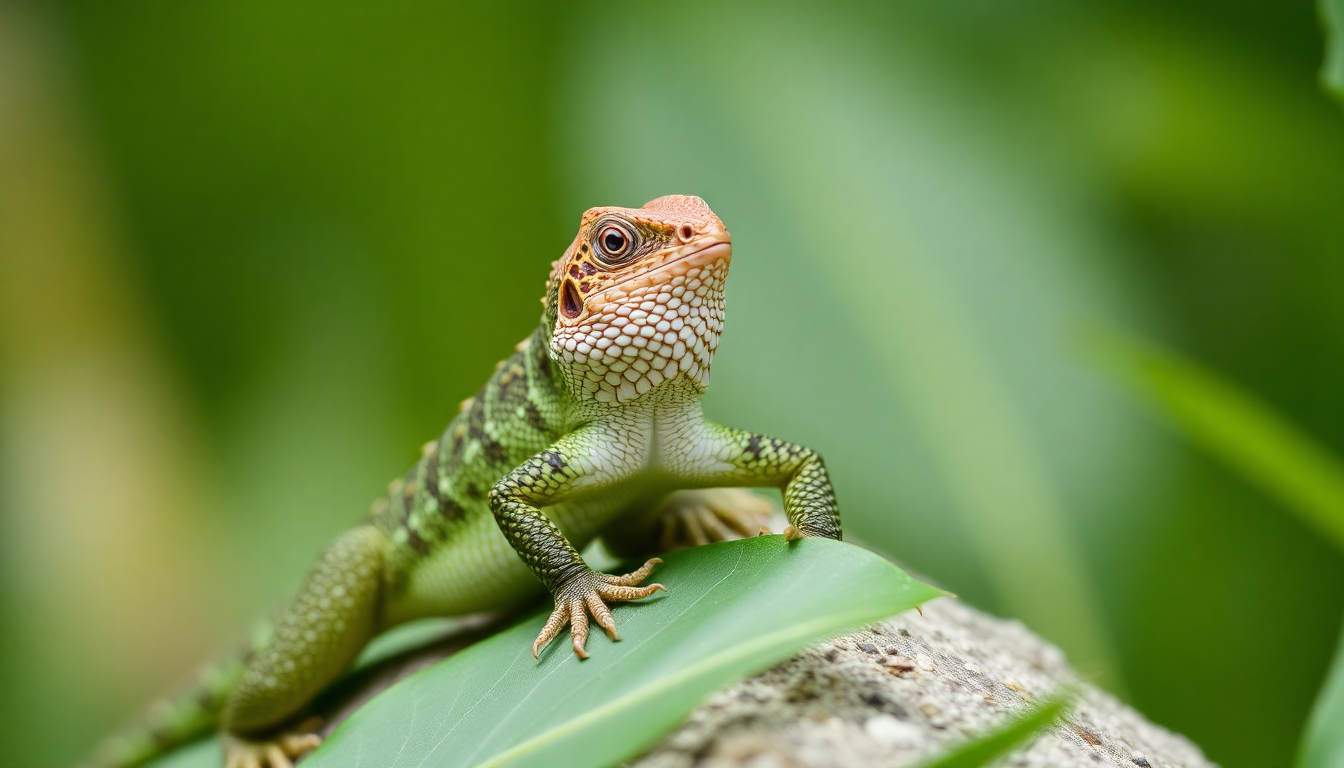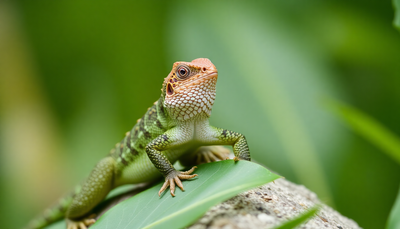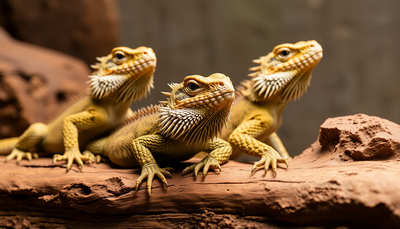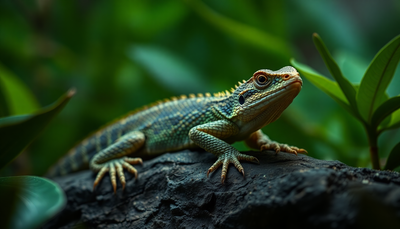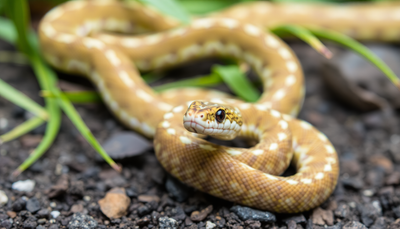Key Takeaways:
- Introduction
- Understanding UVB Rays
- Importance of UVB Percentage
- Exploring 6% UVB Strength
- Exploring 12% UVB Strength
- Exploring 14% UVB Strength
- Skin Types and Tanning: Finding the Right Match
- Potential Risks of Higher UVB Strength
- Making an Informed Choice
Introduction
Understanding UVB Rays
UVB rays are a type of ultraviolet radiation emitted by the sun, specifically responsible for stimulating the production of vitamin D in the skin, which is crucial for several bodily functions, including maintaining healthy bones. Understanding the role of UVB rays is essential when it comes to skin health and environmental exposure. They not only aid in tanning but also play a significant part in protecting against various skin conditions. However, the intensity and percentage of UVB rays can vary greatly depending on several factors—including time of day and geographical location—which can affect your choices in UVB lighting for reptiles and other applications.
Importance in Tanning and Skin Health
When discussing the quest for the perfect tan, UVB percentage is a critical element. It affects how quickly your skin can tan, as well as its overall health. A higher percentage of UVB will speed up the tanning process, but it can also increase the risk of sunburns and skin damage. Thus, finding the right balance is fundamental for achieving a healthy glow without compromising skin integrity. The debate between 6% vs 12% vs 14% UVB is paramount for those making informed decisions regarding tanning beds, light therapy, and even lighting for pet habitats, such as turtle or lizard enclosures.
Navigating the UVB Percentage Guide
This guide aims to clarify the nuances of choosing the appropriate UVB percentage for reptiles and how it ties back to their health and well-being. Our objective is to present a concise yet comprehensive overview that resolves the confusion surrounding “How much UVB is actually necessary?” By delving into the specifics of choosing UVB bulb strength, we hope to empower readers—be it avid reptile owners or sun-seekers—to make choices that not only shelter but also enhance their and their pets’ quality of life. Here, we will unfold the practical implications of different UVB percentages, making it easier for you to understand and adapt your selections based on needs, preferences, and safety.
Understanding UVB Rays
As we delve deeper into the world of UVB lighting for reptiles, understanding the intricacies of UVB rays becomes essential. UVB rays play an integral role in the natural tanning process, significantly affecting the health and well-being of tropical and desert reptiles alike. With so many options available in terms of UVB bulb strength, grasping the functionality of 6% vs 12% vs 14% UVB is crucial.
What Are UVB Rays?
Ultraviolet B (UVB) rays are a type of ultraviolet radiation emitted by the sun, with wavelengths ranging from 280 to 320 nanometers. Unlike UVA rays, which penetrate the skin more deeply, UVB rays are primarily responsible for stimulating the production of vitamin D in the skin, a crucial nutrient that helps facilitate calcium absorption and bone health in reptiles.
The Role of UVB in the Tanning Process
During exposure to UVB rays, the skin undergoes a transformation that leads to the tanning effect. This process involves direct damage to the skin's DNA, which, paradoxically, triggers a protective response. As reptiles bask under the sun or beneath their UVB light sources, they create melanin, the pigment that darkens their skin. This natural defense mechanism not only offers a cosmetic change but also helps mitigate the harmful effects of UV radiation.
“Understanding the role of UVB in vitamin D synthesis is crucial for ensuring the well-being of reptiles in captivity.”
Differences Between UVB and UVA Rays
When comparing UVB to UVA rays, it’s essential to note a few key differences. UVA rays, with longer wavelengths ranging from 320 to 400 nanometers, penetrate the skin more deeply and are primarily associated with skin aging and the development of skin cancer. Conversely, UVB rays, though less penetrating, are significantly more intensive in their effect on the outer skin layers, inducing tanning and thereby playing a pivotal role in vitamin D synthesis.
In summary, the understanding of UVB rays is imperative for those seeking to provide optimal care for their reptiles. Choosing the right UVB bulb strength can make all the difference, as variations in strength—such as 6% vs 12% vs 14% UVB—cater to different species’ needs. Therefore, it is vital to assess factors such as habitat, species, and individual health to achieve the best outcome in terms of lighting and health.
Importance of UVB Percentage
Understanding UVB Rays and Skin Exposure
The percentage of UVB rays emitted by a bulb plays a crucial role in how effectively reptiles can synthesize vitamin D3, a vitamin vital for their overall health. When selecting the right lighting for your reptile, it’s important to consider that higher UVB percentage means increased exposure. This exposure not only aids in tanning results for certain reptiles but also significantly influences their metabolic processes.
Comparing UVB Bulb Strengths: 6% vs 12% vs 14%
By examining the differences in UVB bulb strength, we can gain insight into how these various percentages affect the behavior and health of reptiles. The following table summarizes the characteristics of commonly used strengths:
| UVB Percentage | Recommended Use | Typical Reptiles Benefited |
|---|---|---|
| 6% | Ideal for low UVB exposure species | Some geckos, lowland species |
| 12% | Suitable for moderate UVB exposure | Bearded dragons, box turtles |
| 14% | Best for high UVB requirement species | Desert-dwelling reptiles, Iguanas |
Tanning Results and Skin Health
The tanning results from UVB exposure can drastically vary depending on the strength. A 12% vs 14% UVB bulb may provide a more pronounced tanning effect, which is essential for species that are accustomed to intense sunlight in their natural habitats. However, while a tan can signify healthy exposure, it’s crucial to keep in mind that too much UVB can lead to skin damage, including burns or other long-term dermal complications.
Potential Skin Damage from Excessive UVB
Just like humans, reptiles can suffer from the adverse effects of excessive UVB radiation. Overexposure can lead to a range of issues from skin irritation to serious conditions such as skin cancer. Therefore, understanding the best UVB percentage for reptiles is pivotal in maintaining a balance between obtaining beneficial exposure without crossing into harmful territory. It is also advisable to monitor your reptile's behavior and health regularly, adjusting the strength and duration of exposure accordingly.
Exploring 6% UVB Strength
Characteristics of 6% UVB Strength
When considering UVB lighting for reptiles, understanding the characteristics of various UVB strengths is vital. The 6% UVB strength is particularly suitable for reptiles and amphibians that thrive in lower UVB exposure environments. This strength emits a moderate level of UVB radiation, providing enough depth for reptile health without overwhelming the animal. The ideal use reflects natural habitats that have partial sunlight, replicating foreground elements found in more sheltered areas, such as woodlands or under foliage.
Appropriate Skin Types for 6% UVB Bulbs
Particular reptile species have skin types that respond favorably to 6% UVB bulb strength. Species like leopard geckos, anoles, and certain types of chameleons exhibit a lower requirement for UVB exposure compared to their counterparts. These animals generally possess thicker skin, which protects them from excessive UV radiation, making 6% an optimal choice. Implementing a bulb with this strength helps in maintaining their vitamin D3 levels, crucial for proper calcium metabolism.
Expected Tanning Results
Utilizing a 6% UVB bulb can yield excellent tanning results for reptiles that do not need intense UVB levels to synthesize vitamin D3. Generally, the expected outcome is a gradual tanning effect, which can enhance the animal's overall coloration and health. With consistent exposure, responsible heat management, and a suitable habitat setup, reptiles can indeed thrive. It is essential, however, to monitor the Best UVB percentage for reptiles in your specific setup, ensuring you avoid overexposure, which can lead to harmful effects.
Integrating 6% UVB into Your Setup
Incorporating 6% UVB lighting for reptiles into your habitat not only fosters a healthy environment but also encourages natural behaviors in your pets. Properly positioning the bulb at an appropriate distance—generally about 12 to 18 inches above the basking area—is crucial for optimal exposure. Pairing the 6% UVB bulb with appropriate basking temperatures will help bridge the gap between environmental and biological needs, assisting in the prevention of metabolic bone disease.
As you explore the details of Choosing UVB bulb strength, remember that a well-informed decision is essential for your reptile's health and longevity. Engaging with the community, seeking advice, and sharing experiences can also enhance your understanding and application of UVB strengths in your reptile care routine. What are your experiences with different UVB strengths? Share in the comments below!
Exploring 12% UVB Strength
When it comes to selecting the right UVB bulb for reptiles, 12% UVB strength stands out as a popular choice among enthusiasts and pet owners alike. Offering a balanced approach to both accessibility and effectiveness, this strength provides crucial benefits for your reptiles’ health and well-being. Let us delve into the characteristics and features of 12% UVB bulbs, including their recommended skin types and the intensity of tan they provide.
Characteristics of 12% UVB Strength
12% UVB strength is typically ideal for medium to large reptiles that require substantial exposure to UVB rays. This intensity allows for optimal vitamin D3 synthesis, contributing to better calcium absorption and preventing metabolic bone disease. The specific wavelength emitted makes it suitable for a variety of species, enhancing their activity levels and overall health.
Recommended Skin Types
If your reptiles have a thicker skin, such as certain species of tortoises or larger lizards, a 12% UVB bulb is often recommended. Conversely, those with thinner or more sensitive skin types may benefit from a lower UVB percentage. Understanding your pet's specific needs will help in making informed choices when it comes to choosing UVB bulb strength.
Intensity of Tan Provided
For those looking to achieve that sun-kissed glow for their reptiles, 12% UVB strength is known to provide a moderate intensity of tan. While lower strengths might lead to less pigmentation, the 12% UVB bulbs strike a balance, allowing for ideal coloration without risking overexposure. However, it's essential to ensure a proper distance is maintained to avoid UVB-related health issues.
| UVB Percentage | Recommended Species | Skin Sensitivity | Intensity of Tan |
|---|---|---|---|
| 6% | Young Tortoises, Smaller Lizards | High | Light |
| 12% | Medium to Large Lizards, Tortoises | Medium | Moderate |
| 14% | Larger Reptiles, Iguanas | Low | High |
In summary, selecting the best UVB percentage for reptiles hinges significantly on factors such as species, skin type, and desired exposure. For those considering 12% UVB strength, it stands as a balanced choice, offering enhanced health benefits while ensuring proper precautions are taken for your reptile's unique needs. If you have any specific questions or personal experiences regarding the use of UVB lighting for reptiles, feel free to share them in the comments below!
Exploring 14% UVB Strength
Characteristics and Features of 14% UVB Strength
The 14% UVB strength bulbs are notable for their high intensity, designed to replicate the natural sunlight that reptiles would typically bask under in their native habitats. These bulbs emit a powerful wavelength of UVB, making them particularly effective for larger enclosures or for reptiles that require significant UV exposure to synthesize vitamin D3. This high output is crucial for promoting optimal health and preventing diseases related to calcium deficiency, such as metabolic bone disease (MBD).
"The right UVB lighting can significantly enhance the quality of life for reptiles, helping to mimic their natural environment." - Reptile Care Expert
Target Audience for 14% UVB Bulbs
The ideal users of 14% UVB bulbs are often enthusiasts and keepers of highly active reptiles or those with larger species, such as iguanas, monitors, and tortoises, that thrive under intense UVB conditions. Additionally, these bulbs are suitable for herpetoculturists who are committed to maintaining the well-being of their reptiles through proper lighting. This strength is also recommended for arid desert-dweller species, which require a UV index akin to their native habitats.
Types of Tanning Outcomes with 14% UVB
When using 14% UVB lighting for reptiles, the tanning outcomes are dramatic. These bulbs facilitate quick and efficient vitamin D3 synthesis, leading to robust calcium absorption, which is essential for bone health. Reptiles exposed to appropriate UVB levels exhibit optimal coloration and energy, showcasing vibrant scales and improved activity levels. Owners can expect to see their pets basking confidently, as they instinctively seek out the right light conditions to regulate their body temperature and maximize metabolic functions.
With the right setup, including appropriate distance and placement of the bulb, the positive effects of 14% UVB bulbs can lead to enhanced longevity and vitality in your reptiles. Remember that while higher percentages yield more benefits, it's crucial to monitor exposure duration to prevent overexposure, which can be harmful.
"Optimal UVB lighting can transform a habitat from basic to extraordinary, making it a crucial component in reptile husbandry." - Leading Reptile Keeper
Skin Types and Tanning: Finding the Right Match
Understanding the UVB percentage guide is crucial when it comes to selecting the appropriate UVB lighting for reptiles. Just as various reptiles have distinct lighting needs, human skin types also respond differently to UVB exposure, which is why recognizing the nuances is integral to safe and effective tanning.
Skin Types Explained
Human skin is classified into several types, primarily based on its melanin content and sensitivity to UV rays. These classifications help in determining the best UVB percentage for reptiles and for humans alike. The commonly recognized skin types include:
- Type I: Very fair skin, often burns easily, never tans.
- Type II: Fair skin, burns easily, tans minimally.
- Type III: Medium skin, sometimes burns, tans gradually.
- Type IV: Olive skin, rarely burns, tans well.
- Type V: Brown skin, very rarely burns, tans easily.
- Type VI: Dark brown or black skin, virtually never burns.
Response to Different UVB Percentages
When it comes to choosing UVB bulb strength, skin types play a significant role in how effectively individuals can absorb UVB light. Here’s how various UVB percentages react with skin types:
- 6% UVB: Ideal for Type I and II skin types, offering a gentle introduction to UV exposure while minimizing the risk of burning.
- 12% UVB: Suitable for Type III and IV skin types, this percentage provides a balance between effective tanning and safety, enabling a good tan without excessive risk.
- 14% UVB: Best for Type V and VI skin types, which can handle a more intense UV exposure, facilitating deeper tanning with minimal concern for burning.
Safety First
Regardless of skin type, safety must always be prioritized when using UVB lighting. Here are tips to ensure a safe tanning experience:
- Start with shorter exposure times and gradually increase as your skin adjusts.
- Monitor your skin's response and be vigilant for any signs of burning or irritation.
- Use protective measures such as sunscreen or protective clothing when needed.
By considering your skin type and the corresponding 6% vs 12% vs 14% UVB options, you can make an informed decision that prioritizes both safety and effectiveness. This tailored approach will not only enhance your tanning experience but also ensure your skin remains healthy and vibrant.
Potential Risks of Higher UVB Strength
Understanding Skin Damage
As we dive deeper into the UVB percentage guide, it’s essential to recognize that while UVB lighting is crucial for the health of reptiles, a higher UVB percentage, such as 12% or 14%, can pose risks. Too much exposure to UVB radiation can lead to significant skin damage. Just like humans, reptiles are susceptible to the harmful effects that overexposure to UVB light can cause. The most common issue is sunburn, which manifests as redness and peeling of the skin. Reptiles may exhibit behaviors such as hiding or becoming lethargic when experiencing skin discomfort, which signals that immediate adjustments in their lighting setup are necessary.
Increased Risk of Skin Cancer
One alarming risk of prolonged exposure to high UVB levels is the increased likelihood of skin cancer. Just as with higher UVB percentages of 12% and 14%, the ultraviolet rays can lead to mutations in the skin cells of reptiles, creating a higher risk for malignancies. Reptile owners should be particularly cautious when choosing UVB bulbs, as this can drastically affect the health of their pets. It's essential to monitor their time under these lights and ensure they have shaded areas available to escape direct exposure when needed.
Behavioral Changes and Stress
Excessive UVB exposure not only results in physical ailments but can also lead to behavioral changes and increased stress in reptiles. Overexposure can cause anxiety, leading reptiles to display signs of stress such as excessive hiding or aggressive behavior. It’s crucial to be aware of how your reptiles react to their environment, especially when introducing new UVB lighting. Regular observation and adjustments can mitigate these risks and ensure their well-being.
Finding the Best UVB Percentage for Your Reptiles
Determining the best UVB percentage for reptiles is not a one-size-fits-all solution. While rats and similar reptiles may thrive under a 6% UVB bulb, others may require a stronger bulb to meet their specific needs. It’s essential to consider factors such as the animal’s species, age, and habitat when selecting the ideal bulb strength. To prevent potential risks associated with higher UVB percentages, a gradual introduction to stronger lighting can help assess how your reptiles adapt to their environment.
In conclusion, while UVB lighting is vital for the health of reptiles, higher percentages come with inherent risks. By understanding the implications of choosing UVB bulb strength, particularly the potential for skin damage and increased skin cancer risk, reptile owners can make more informed decisions. Monitoring your pet’s exposure and ensuring a balanced environment will lead to a healthier, happier reptile.
Making an Informed Choice
When it comes to selecting the right UVB percentage for your reptiles, understanding the nuances of 6% vs 12% vs 14% UVB can be a decisive factor in achieving optimal health and well-being for your pets. As you weigh your options for UVB lighting for reptiles, there are several important considerations to keep in mind:
Understanding Desired Results
Your intent behind using UVB lighting plays a significant role in determining the right percentage. Different reptiles have varying degrees of UVB light requirements based on their natural habitats. Here’s a breakdown of considerations:
- Outdoor or Indoor conditions: If reptiles spend considerable time outdoors, a lower UVB percentage may suffice. Conversely, indoor reptiles may need stronger options.
- Species-specific needs: If your reptile is a basking species, opting for a 12% or 14% UVB could be optimal, whereas a 6% UVB may be adequate for less active species.
Considering Skin Type
The skin type of your reptile is also crucial when choosing the appropriate UVB bulb strength. Reptiles with thicker skin may absorb UV radiation differently. Here’s what to consider:
- Thick-skinned reptiles: Species like tortoises and iguanas can tolerate higher UVB output due to their robust skin.
- Thin-skinned reptiles: Geckos and similar smaller species might need gentler lighting, making a 6% UVB option more suitable to avoid skin damage.
Health Considerations
Your pet’s health and activity level are paramount when selecting the best UVB percentage for reptiles. Some key points to keep in mind include:
- Age: Hatchlings and juvenile reptiles might benefit from lower UVB exposure to help them acclimate.
- Health conditions: If a reptile has been diagnosed with health issues, consulting a vet regarding appropriate UVB exposure is advisable.
- Behavior: Monitored basking behaviors will give clues—if they seek direct exposure often, consider increasing the strength of UVB lighting.
Ultimately, each reptile's needs vary, and understanding these guidelines for consumers can empower you to make an informed choice. By carefully assessing your reptile's desired outcomes, skin characteristics, and overall health, you can confidently select the right UVB bulb strength, ensuring a thriving environment for your beloved pet.
Conclusion
In conclusion, understanding the UVB percentage guide is essential for providing the optimal lighting conditions for your reptiles. As we’ve explored, the differences between 6%, 12%, and 14% UVB bulbs can significantly impact the health and wellbeing of your pets.
Choosing the right UVB bulb strength is not just about preference; it's about meeting the specific needs of your reptiles based on their species, habitat, and exposure to natural sunlight. The right UVB lighting for reptiles ensures that they can produce the necessary Vitamin D3, absorb calcium effectively, and maintain their overall vitality.
As you reflect on the best UVB percentage for reptiles, consider your pet's particular circumstances and the environment you provide. It’s an investment in their health and an assurance that they thrive in captivity just as they would in the wild.
Take a moment to assess your current setup and whether it aligns with the insights gained here. Are you using the appropriate UVB percentage that matches your reptile's unique requirements? If you haven't already, researching and upgrading your UVB lighting can make a world of difference.
Ultimately, your dedication to understanding and providing the right UVB lighting will lead to a happier, healthier pet. Make the leap to enhance your reptile's habitat today!
Illuminate Your Reptile's Habitat Today! Discover the best UVB lighting for reptiles and ensure their health and happiness. Visit our collection now at Talis US and find the perfect lighting solutions tailored to your pet’s needs. Don't wait—upgrade their environment for optimal care!
FAQs
What is the UVB percentage guide?
The UVB percentage guide provides essential information on the different levels of UVB light emitted by various bulbs, helping reptile owners choose the appropriate lighting for their pets. The guide typically ranges from 2% to 14%, indicating the strength of ultraviolet light produced.
How do I choose UVB bulb strength for my reptile?
When choosing UVB bulb strength, consider the species of your reptile, its habitat, and its natural exposure to sunlight. Different reptiles have different UVB requirements, so it's crucial to match the bulb strength to their specific needs.
What’s the difference between 6%, 12%, and 14% UVB bulbs?
The differences between 6% vs 12% vs 14% UVB bulbs lie in their output intensity and suitable distance from the basking area. Generally, a 6% bulb is adequate for reptiles that enjoy partial UVB exposure, while 12% and 14% are recommended for species that require stronger UVB, such as desert-dwelling reptiles.
Why is UVB lighting important for reptiles?
UVB lighting for reptiles is essential for their ability to synthesize vitamin D3, which is crucial for calcium metabolism. Without adequate UVB exposure, reptiles can suffer from metabolic bone disease and other serious health issues.
What is the best UVB percentage for reptiles?
The best UVB percentage for reptiles varies based on species. Generally, 10-12% UVB is recommended for most lizards and younger tortoises, while some species may require 14%. Always confirm the specific needs of your reptile species to ensure optimal health.


